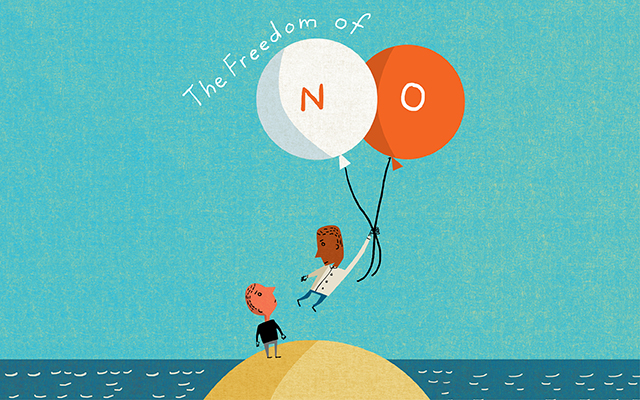Some years ago, I was an online producer at a business magazine. I didn’t love the subject matter, but I loved the job — I was learning new things, and I enjoyed the challenges. The atmosphere was friendly and the amenities extravagant. Free snacks! Weekly rooftop happy hours! Laptops for everyone! I felt lucky to work there.
When the economy took a downturn, we all assumed it would bounce back. But then people began getting laid off. “Do you mind taking Jennifer’s responsibilities for a bit?” my manager, David, asked me, after he’d let her go.
“That’s fine,” I responded. I was happy to remain employed.
A week later, David reappeared to ask if I’d also take on Tom’s work. “Sure, no problem,” I said, ignoring the pain beginning to blossom in my fingers and wrists from all the extra hours I was spending on my keyboard.
More rounds of layoffs ensued, my hours and duties continued to increase (though my salary didn’t), and my tired hands became aching hands, then numb and tingling hands. My wrists screamed in pain.
I started seeing an acupuncturist twice a week and using voice recognition software. Each time my boss would add more tasks to my list, I tried to say no, but I couldn’t — I was too afraid. I feared that if he saw me as uncooperative, I’d be next on the chopping block. I’d seen how expendable my coworkers were.
The pain soon became excruciating, and a doctor who specialized in work-related injuries ordered me to reduce my hours by half. Trying to appear nonchalant, I minimized the doctor’s report when I asked for a schedule reduction. David waved off my restrictions as if they were nothing to take seriously. I didn’t blame him — I didn’t communicate their seriousness.
Meanwhile, the damage was done. Even five minutes on a keyboard left me in tears. Finally, I had no choice: I told David that when the next round of layoffs happened, I wanted to be on the list.
I didn’t need to ask. I was already slated for the final round before the magazine shut down.
It took almost three years before the pain of that unsaid no fully disappeared — a high price to pay for what had become a decidedly unpleasant job. This gave me plenty of time to ponder my fear of saying no.
I’ve since learned that, for many, saying no is easy, just like how skydiving is no big deal for some people. For others, however, saying no can feel exactly like parachuting out of a plane: big risks, uncertain rewards. If you’re in the latter camp, it’s worth investigating your resistance sooner rather than later. Getting more comfortable with the little word can make a big difference in the quality of your life and well-being.
Why It’s Hard to Say No
 Illustrations by James Yang
Illustrations by James YangSometimes we’re afraid of how people might react when we refuse.
“People we’ve said no to may feel sadness, disappointment, even anger,” explains Robin Stern, PhD, a psychoanalyst and associate director of the Yale Center for Emotional Intelligence. “For many people, the thought of making someone feel that way, and having to deal with those feelings, is very uncomfortable.”
A power imbalance in a relationship can make saying no even harder, Stern notes, especially if you’re dealing with “someone who can hurt you or take something important away from you.” (This is how I felt when I was afraid for my job at the magazine.)
New technologies make it easier for people to make requests around the clock, and this means they often reach us when we’re tired and our resistance is flagging. I have a client who, until recently, emailed me at all hours. If I didn’t respond within four minutes (literally four minutes) she’d email and text, asking if I had received her message. Her urgency made it even harder to refuse her requests; because she’s a client, I wanted to please her.
Many of us struggle to create healthy boundaries, which Stern says is not uncommon — even when the balance of power is relatively equal.
“If you’ve been trained to be a people pleaser, then the urge to say yes comes first,” she says, adding that these blurry communication boundaries can create a “below-the-surface contract.” This can be difficult to escape.
Award-winning television producer Shonda Rhimes writes about this dilemma in her 2015 memoir, Year of Yes. Though Rhimes basically rules network television on Thursday evenings — she’s responsible for Grey’s Anatomy, Scandal, and How to Get Away With Murder — she struggled for years with saying no. She says friends took advantage of her because of her unclear boundaries.
“Everyone knows how difficult it is to say no,” she writes. “It’s one of the reasons why people seem to be comfortable asking you for favors they have no business asking you for. They know how hard it is.” (Struggle with setting boundaries? See “How to Set Clear Boundaries“.)
She remembers when she finally learned saying no is worth the trouble.
Rhimes was casting the pilot for Grey’s Anatomy. An actor had been picked for the lead role and Rhimes felt sure she was the wrong choice. Still, she was initially unwilling to challenge the decision. She remembers being afraid to have a different opinion than everyone else.
After stifling herself as long as she could, Rhimes finally blurted out “No!” during a conference call. Her shocked colleagues tried to change her mind. “No,” she said, more forcefully. “I do not want her. I do not want to write for her. No. No. NO.”
“That was my very first no at work,” she explains. “My first moment of asserting myself as the leader, the captain of what we all thought was going to be a tiny sailboat . . . but turned out to be a gigantic ocean liner.”
That no, which she now calls her “favorite no,” transformed her work atmosphere. It made her comfortable with her own authority.
“Because of that no,” she writes, “I decided that I was steering the ship. I started behaving like the thing in my brain was our only true north. And that we would be guided by it no matter what.”
How an Endless Yes Can Harm Your Health
 Illustrations by James Yang
Illustrations by James YangYet nothing is further from the truth.
“People often feel harried and busy because they’re spending their time in ways that don’t align with their desires. They’re doing things they feel they should do, but not things they want to do,” says Christine Carter, PhD, a sociologist and senior fellow at the Greater Good Science Center at the University of California, Berkeley.
“If you’re living your life for other people — if, for example, you’re a people pleaser who can’t say no when someone invites you to an event — you’re going to end up feeling resentful,” she says.
Resentment is only one of the hidden costs of a life governed by yes. Refusing to set limits also harms us physically. When we’re overburdened, Carter says, our body can perceive the situation as an attack.
“It feels like a threat, which will make the flight-or-fight response kick in,” she explains. The sympathetic nervous system responds by releasing a flood of cortisol, adrenaline, and norepinephrine to help the body save itself from an encroaching threat — whether it’s a hungry bear or an angry boss. Our heart rate and blood pressure spike. Our digestive and immune systems shut down to allow more energy for fighting or fleeing.
Spending too much time in this state leads to chronic stress. Related health problems include insomnia, a higher risk of stroke, and a weaker immune system. (For more on this, see “Reset Your Stress“.) Returning repeatedly to the fight-or-flight mode can also make us even more prone to flip out, Carter says. “Our nervous systems become trained so that we react in bigger ways to smaller stimuli.”
In this respect, declining obligations that we neither have to do nor want to do is itself an act of self-preservation. Using good judgment about who and what deserves our time and energy allows us to give our best. It also makes us more trustworthy when we do say yes; we set better boundaries, which are important for all relationships — with partners, friends, bosses, and our kids.
Thankfully, saying no is a skill we can all learn.
How to Say No: A 3-Step Plan
1. Get Clear
Saying no is easier when you’re clear about your reasons. Having a stable routine that largely determines how you use your time, energy, and other resources can also help you protect them.
Carter blocks out time on her calendar for working (in the morning when she says she’s liveliest), for hiking with her dog, even for checking email. She limits her evening social obligations to two events a week and schedules no more than one media interview a day. By setting crisp boundaries like this, Carter has real, practical reasons to decline invitations or requests. Because she only accepts a limited number, she has to evaluate each one carefully before saying yes, and therefore is more likely to feel good about each decision.
Similarly, if you find it hard to say no when people ask you for money or other assistance, you can create a monthly budget for your resources (this may include money, time, or services). When it’s gone, it’s gone. That boundary will protect you from the impulse to keep giving out of guilt or habit.
Finally, if you don’t want to do or give something, don’t make up an excuse, she warns; it will only lead to further entanglements. Lying also sends your mind and body the message that there’s something wrong with saying no when there really isn’t. It’s a perfectly good answer.
2. Rehearse Your Response
The second of Carter’s three steps is to rehearse kind but firm ways of saying no — before you need them. This helps cut down on the inevitable discomfort of turning down a request.
“No one wants to disappoint someone; it’s uncomfortable,” she says. “It takes vulnerability and courage to feel discomfort. But it’s important. Living a happy life involves some discomfort.”
As for the exact words to use, that’s up to you, she says. “You’ll find a response that works, and that’ll be your default.”
Carter does have some guidelines and suggestions, though. Steer clear of specifics or explanations, like “I have to take Johnny to soccer practice,” because a well-meaning person might offer to take Johnny for you. So be honest, and don’t be afraid to be vague. Endless verbal gymnastics and explanations imply that the other person can’t handle a simple no. If you treat people like they can handle it just fine, you’ll be surprised by how often they do.
Something simple, like “I’m unable to do that on that evening,” is almost always sufficient. Here are some other friendly but firm options:
- “I’d love to, but I can’t.”
- “Thank you for asking, but no.”
- “I can see this is important to you, but I’m not able to.”
- “I don’t want to disappoint you, but I have to say no.”
- “That doesn’t work for me this time.”
If someone continues to pressure you, you can always just repeat your point calmly. (See “When Someone Won’t Take No for an Answer,” below.)
3. Find the Yes
Focus on the rewards of saying a particular no, says Carter. The payback is often immediate.
“Say you didn’t go to book club on Wednesday because you’d already been out twice that week, or maybe you didn’t like the book,” she says. What did you get instead? “Maybe you had a few more hours to read a book you actually did like, or more time to spend with your spouse and kids. That’s great! Focus on that.”
This strategy can be a great tool for offsetting FOMO, or “fear of missing out,” which is often provoked by cultural pressures to accept all or most invitations lest you be absent from the one event that really counts.
FOMO is a kind of mental booby trap. The brain reacts to perceived loss, Carter says, which means whatever we don’t do can feel like an actual loss. By focusing on what we’ve gained from saying no, we reframe that hypothetical loss as a prize. Then we feel the pleasure of reward instead. (For more on FOMO, visit “Getting Past FOMO“.)
Rhimes now has a simple strategy. “I treat saying no in the same way I treat saying thank you. Say no and then don’t say anything else.”
Her approach was born of necessity: She had a friend who asked her for a large sum of money. When she finally worked up the courage to say no, the friend got angry. She ranted.
Rather than feeling heartbroken, Rhimes felt as if she’d been set free. The worst was happening, and she was just fine.
It isn’t so awful, she thought, in that moment. “I’m happier knowing what kind of person this really is,” she writes.
While the first no was her favorite no, that no made her feel like she’d gained a superpower.
As for me, I’ve found a way to deal with my demanding client, and it’s taken from a page in Rhimes’s book: No work emails after 7 p.m. So far, it’s working beautifully — and my hands have never felt better.
When Someone Won’t Take No for an Answer
 Illustrations by James Yang
Illustrations by James YangNot everyone accepts the word “no” gracefully. Robin Stern, PhD, a psychoanalyst and the associate director of the Yale Center for Emotional Intelligence, recommends the following approach when dealing with someone who resists your no:
- Be both firm and kind.
- Remember that you don’t need the person to accept your refusal. You just need to say it and stick to it.
- If you’d like, you can add, “I understand this is hard to accept,” or “I wish I felt differently.”
- If the person still won’t back down, tell him or her that you feel uncomfortable. Be clear about your feelings.
- If the person still won’t relent, then it’s probably a good time to reevaluate the relationship. Is it worth keeping?





This Post Has 0 Comments